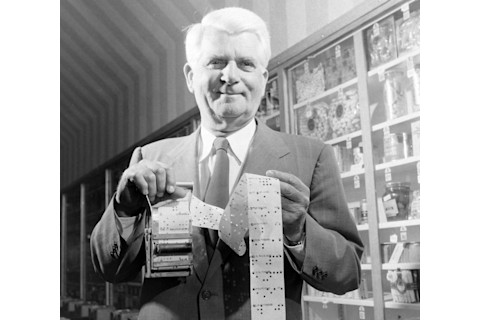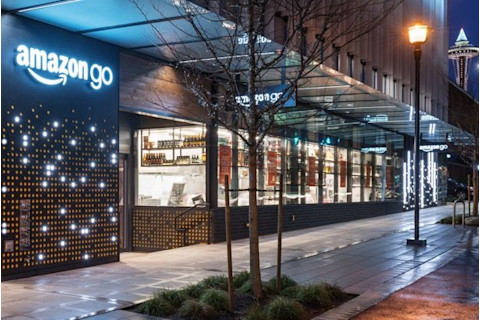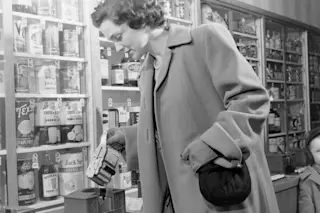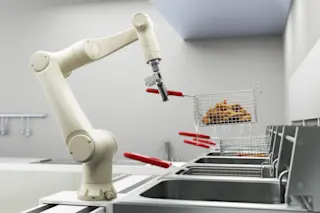A customer turns her key at a Keedoozle. (via Afflictor) Maslow’s motivational pyramid is but a house of cards if we don’t eat. And ever since we started shoving sustenance into our gullets, our species has devised means to do it faster—lest we beleaguer our journey to transcendence. In 2011, a team of archaeologists working near Kenya’s Lake Turkana unearthed several stone tools in sediment that was 3.3 million years old; they were the oldest ever found. From this starting point chiseled from stone, the parabolic arc of meal-gathering technology—arrowheads, taming wheat, spears, domesticating goats, irrigation, barcode scanners—has traced a path squarely through the turnstiles of Amazon Go.Amazon on Monday opened its first cashier-less convenience store in Seattle with the typical fanfare that accompanies just about everything Amazon does. After a 14-month internal trial, anyone with an Amazon Go account can now scan their smartphone at the door and go to town. Customers pick up any items they want and just walk out, all the while an array of sensors and cameras completes the transaction and tracks inventory. In keeping with trendy tech ritual, famished technomaniacs formed their customary, pre-dawn line outside, eagerly awaiting their chance to partake in hyper-efficient, faceless transactions. The irony wasn't lost on some:
I’m in Seattle and there is currently a line to shop at the grocery store whose entire premise is that you won’t have to wait in line. pic.twitter.com/fWr80A0ZPV
— Ryan Petersen (@typesfast) January 22, 2018
“This is the future of grocery shopping,” Yuval Fleming, among those standing in line, told the USA Today and KING 5
on Monday. Here, Amazon’s mantra for the future of grocery is “Just Walk Out.” It’s a catchy, three-word ode to convenience that has an uncanny echo in the halls of history. Eighty years ago, Clarence Saunders, the founder of Piggly Wiggly grocery stores, also saw the future of grocery shopping. In 1937, he opened the first automated grocery store in Memphis, Tennessee. His three-word ode to convenience: “Key Does All”.

Clarence Saunders holds a key for the Keedoozle experience. (via Afflictor)
The Future, 80 Years Ago
When it came to 20^th-century grocery innovators, Piggly Wiggly was at the tip of the spear. Saunders founded the company in 1916 at a time when customers still handed their grocery lists to clerks awaiting their business from behind a counter. Clerks gathered all the items; customers didn’t roam the store. You didn't touch your groceries until you had paid. Saunders flipped the script, as they say. He designed his stores with aisles of goods, allowing customers to journey through the store and pick up foodstuffs at their leisure. The approach saved on overhead costs, and allowed Saunders to cut prices—ever the goal of grocers. He patented this “self-serving store” concept in 1917. Seriously, selecting your own food at the grocery store was a massive paradigm shift. Piggly Wiggly’s business thrived into the early 1930s with their innovative model, but it all came crashing down when Saunders attempted to ward off a pack of short-selling wolves of Wall Street who were looking to squeeze Piggly Wiggly’s stock
. Saunders is best known for his audacious attempt to buy all his company’s stock shares, corner the market and leave the short-sellers hanging out to dry. He despised Wall Street types. It would be sweet revenge. He came so close, but failed when Wall Street changed rules of the game. Saunders owed millions, and was eventually forced to break Piggly Wiggly apart. But like any good ole’ American corporate legend, Saunders dusted off the ashes and started anew. In 1937, he founded Keedoozle, a grocery store that was essentially a walk-in vending machine (the name
was a play on “Key Does All”). Items were displayed inside cases, and each customer inserted their special key into a slot below a desired item and pulled a trigger to denote quantity. All of the information was punched into paper tape, which guided machines that assembled the order. The products were then sent along a conveyor belt, boxed and the cashier used the paper tape record to process payment. In February 1937, the
carved out a small corner in the paper detailing the new store:
Memphis, Tenn., Feb. 19 — Clarence Saunders sighted along the comeback trail today from behind an impressive array of electrical gadgets and a bright new store he calls “Keedoozle.” The Keedoozle in which electricity conveys the customers purchases to him, and adds up his bill, will open about March 6, Saunders said.
Saunders claimed the labor-saving technology underpinning Keedoozle would allow him to earn 7 percent more
on his sales, while at the same time trimming the cost of items by 3 cents on average. It didn’t work out that way. The Keedoozle was a machine too far ahead of its time, built with custom parts and a one-of-a-kind design. During peak hours, the circuits failed to handle all the traffic. The machinery was complex, unreliable and expensive to fix. It couldn’t compete with the cheap simplicity of supermarket carts, as John Brooks noted in his New Yorker profile, which is enshrined in Business Adventures
(Warren Buffett and Bill Gates say it's the best business book ever written
). Although Saunders opened three pilot stores, they never worked out. Back to the Future, Today Amazon’s “Just Walk Out” technology detects when products are taken off the shelf. It adds them back to the inventory if you, say, set it back on the shelf. Items show up in a virtual shopping cart now, and Amazon sends you the bill when you walk out. It’s a promise of efficiency, convenience, and cost-reducing progress that Saunders sought to achieve. Where Saunders fell short, will Amazon succeed? Will Amazon’s complex web of store technology harmonize where Saunders found discord?

(Credit: Amazon) Already, CNBC exposed a quirk in the Rub Goldberg-eqsue machinery.
I think I just shoplifted?? #AmazonGo didn’t charge me for my Siggi’s yogurt ? #nolinesnocheckout#freestuffpic.twitter.com/RDPhC5ryXD — Deirdre Bosa (@dee_bosa) January 22, 2018
CNBC’s Deirdre Bosa stuffed a few items into her bag and waltzed out of the store. Bosa received her digital receipt, but her single-serve Siggi’s yogurt was never rung up. Bosa promptly confessed to the unintentional crime, but Amazon Go VP Gianna Puerini put her at ease
:
"First and foremost, enjoy the yogurt on us," Puerini said. "It happens so rarely that we didn't even bother building in a feature for customers to tell us it happened. So thanks for being honest and telling us. I've been doing this a year and I have yet to get an error. So we've tried to make it super easy on the rare occasion that does happen either to remove it or enjoy breakfast on us."
If innocent people can accidentally turn to pilfering, will all those cameras and sensors keep the real kleptomaniacs at bay? Certainly, only time will tell. Echoes of history, indeed.














